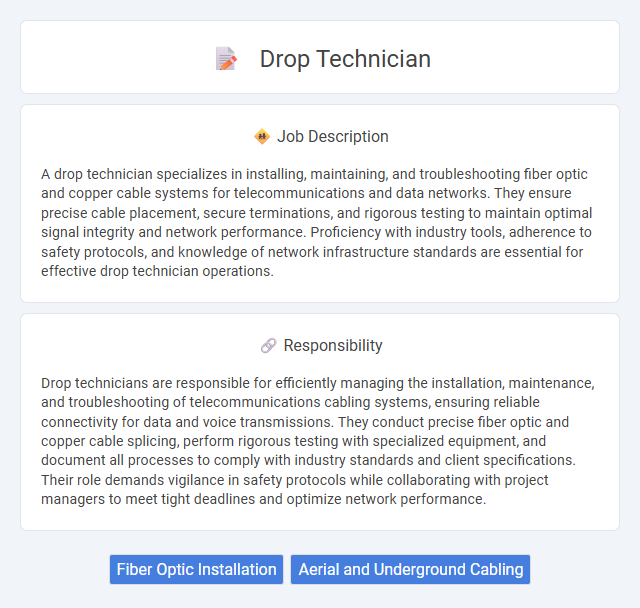
A drop technician specializes in installing, maintaining, and troubleshooting fiber optic and copper cable systems for telecommunications and data networks. They ensure precise cable placement, secure terminations, and rigorous testing to maintain optimal signal integrity and network performance. Proficiency with industry tools, adherence to safety protocols, and knowledge of network infrastructure standards are essential for effective drop technician operations.
Individuals with strong attention to detail and excellent manual dexterity are likely to be suitable for a Drop Technician role, as the job often involves handling delicate equipment. People who thrive in structured environments and can work independently may have a higher probability of success in this position. Those who may struggle with repetitive tasks or physical fatigue might find this role less compatible with their abilities.
Qualification
A drop technician typically requires a high school diploma or equivalent, with specialized training in fiber optic and cable installation techniques. Certification such as ETA Fiber Optics Technician (FOT) or BICSI Installer is highly valued for demonstrating proficiency and safety compliance. Hands-on experience with tools, troubleshooting, and knowledge of industry standards significantly enhances qualification for the role.
Responsibility
Drop technicians are responsible for efficiently managing the installation, maintenance, and troubleshooting of telecommunications cabling systems, ensuring reliable connectivity for data and voice transmissions. They conduct precise fiber optic and copper cable splicing, perform rigorous testing with specialized equipment, and document all processes to comply with industry standards and client specifications. Their role demands vigilance in safety protocols while collaborating with project managers to meet tight deadlines and optimize network performance.
Benefit
Drop technicians likely gain valuable hands-on experience that enhances technical skills and career prospects. This role probably offers opportunities for professional growth through exposure to various devices and repair techniques. Employees may also benefit from competitive wages and flexible schedules that accommodate diverse lifestyles.
Challenge
A Drop technician job likely involves handling complex technical issues that require quick problem-solving skills and adaptability. Challenges may arise from troubleshooting unpredictable equipment failures or software glitches under time constraints. Managing customer expectations while ensuring accurate and efficient service probably demands strong communication and stress management abilities.
Career Advancement
Drop technicians specialize in repairing and maintaining mobile devices, offering crucial technical support in the consumer electronics sector. Mastery of diagnostic tools and advanced repair techniques enables drop technicians to progress into roles such as senior technician, technical trainer, or service manager. Continuous skill development and certification in emerging technologies significantly enhance career advancement opportunities within this rapidly evolving industry.
Key Terms
Fiber Optic Installation
Drop technicians specializing in fiber optic installation are responsible for deploying and maintaining high-speed fiber optic cables that connect end-users to the main network. They perform precise splicing, connectorization, and testing of fiber optic lines to ensure optimal signal quality and network reliability. Expertise in interpreting network blueprints and using specialized equipment like OTDRs (Optical Time-Domain Reflectometers) is essential for efficient fiber deployment and troubleshooting.
Aerial and Underground Cabling
Drop technicians specialize in installing and maintaining aerial and underground cabling systems crucial for telecommunications infrastructure. Their expertise includes fiber optic splicing, cable routing, and ensuring proper signal transmission for high-speed internet and communication networks. Proficiency in safety protocols and the use of specialized tools guarantees efficient deployment and minimal service disruptions in both aerial poles and underground conduits.
 kuljobs.com
kuljobs.com